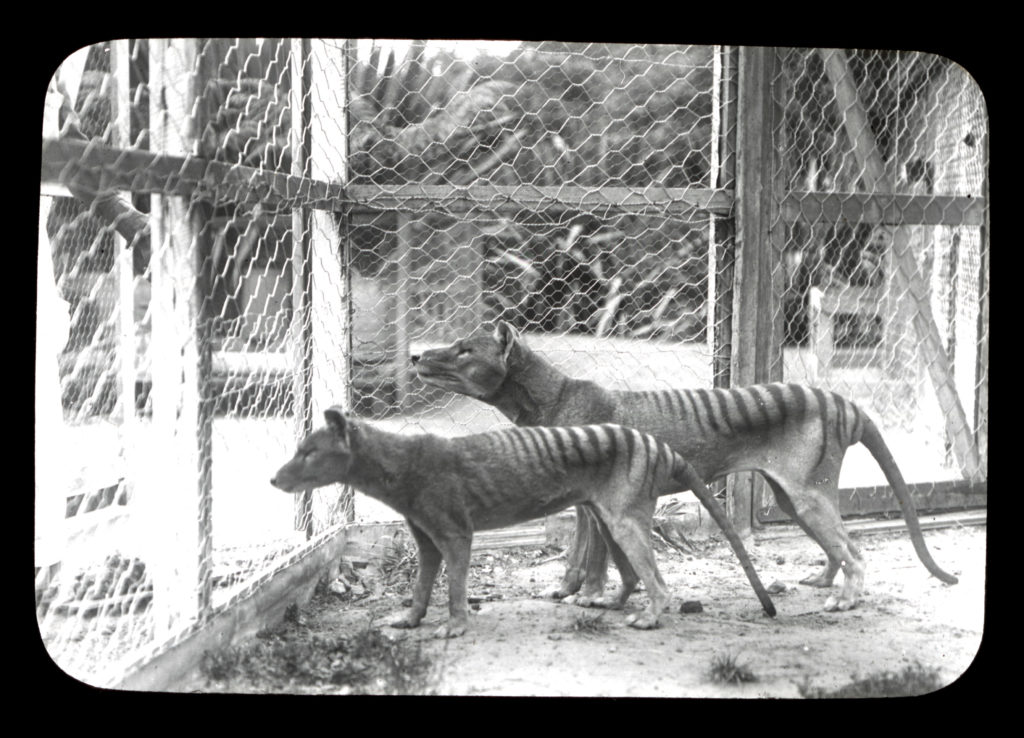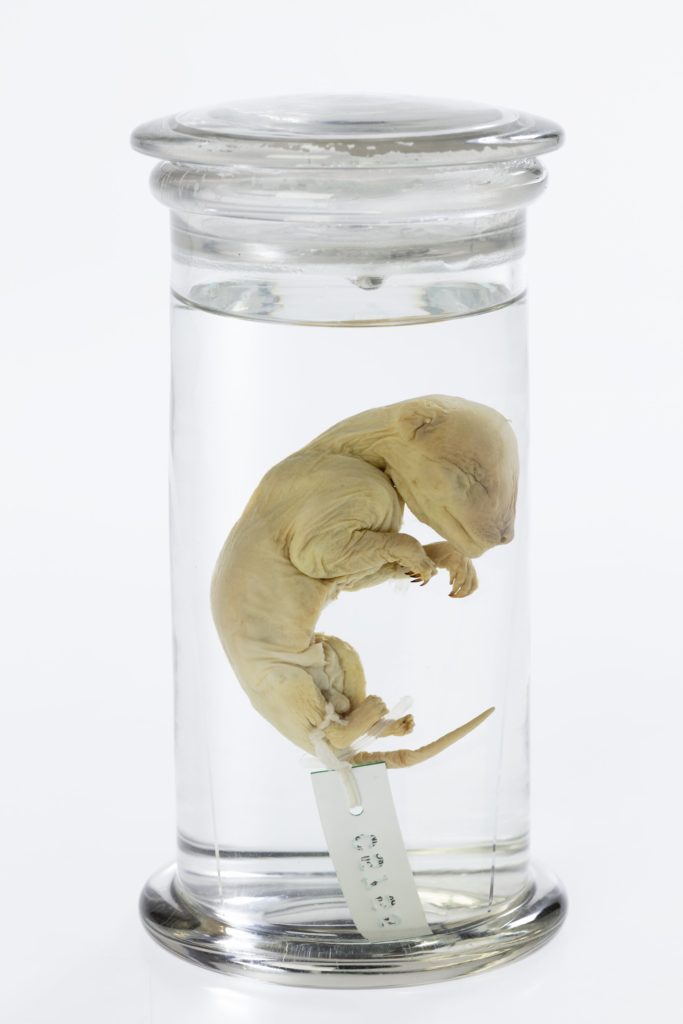Reviving a Ghost of Tasmania: The Ethics and Feasibility of Thylacine De-extinction
By Dr Catriona Nguyen-Robertson MRSV
The thylacine (Thylacinus cynocephalus), or Tasmanian tiger, is an animal that for many Australians is almost a legend. Confined to history, they were driven to extinction. Yet, for an animal that was completely wiped out of existence nearly 90 years ago, it continues to hold a place of endearment in the eyes of the public.
The thylacine was a unique marsupial species that is unlike any around today. As an apex predator that looked physically like dogs and wolves, according to Prof Andrew Pask from the University of Melbourne, ‘it was the king of the marsupials’ until its extinction in 1936.

Unlike its common name suggests, the Tasmanian tiger was once broadly distributed around Australia. However the poor genetic health of the species (much worse than that of the Tasmanian devil in the present day), the introduction of dingoes, and other factors wiped the thylacine from mainland Australia.1,2,3,4 The arrival of Europeans in Tasmania heralded the beginning of the end for thylacine: following claims that they were attacking livestock, in 1888 the Tasmanian government placed a bounty of £1 for each Tasmanian tiger killed. The last-known thylacine died in captivity at the long-defunct Beaumaris Zoo in Hobart, and today, thylacines survive only in old photos, video footage, and preserved in museum collections.
Since its extinction, the thylacine has endured in the Australian consciousness as a symbol of regret for our role in its decline – and the decline of other species. But what if there was a way to bring them back?
And, if there was, should we?
Piecing together a thylacine
The thylacine may be gone, but researchers at the University of Melbourne’s TIGRR (Thylacine Integrated Genetic Restoration Research) Lab, led by Professor Andrew Pask, are working towards its de-extinction. No longer the stuff of science-fiction, bringing a species back from extinction is now a feasible scientific reality.
The first step in reviving an extinct species is to find a good source of its DNA. While DNA is fortunately quite hardy, it is subject to damage by various enzymes, chemicals, microorganisms, and UV light. This means that while there are numerous thylacine samples found in collections and museums, few have been stored in such a way to completely protect the DNA from degradation (although, this is good news for those concerned about a Jurassic Park situation as all dinosaur DNA has been long irreparably destroyed). Andrew pieced together the best-preserved DNA from thylacine specimens – a 10-million-piece puzzle – and sequenced the thylacine genome, providing all the instructions needed to make a thylacine.1

Just because we can, should we?
The thylacine de-extinction project has attracted a large amount of both funding and attention – $15 million of funding, in fact. While it could be argued that this money could be devoted to conservation of animals that are currently endangered, the reality is that they do not receive the same level of focus as the thylacine . “De-extinction” is a buzzword that reels people – and a lot of money – in.
Australia holds the record for the most mammal extinctions5 and many of our animal species are suffering increasing pressures from introduced species, habitat loss, and climate change. This could be an opportunity to change that.
The TIGRR Lab is developing technologies and resources to help preserve and conserve other species. They are developing methods of working with marsupial stem cells, gene-editing marsupial genomes, and assisted reproductive techniques for marsupials. If we could edit the DNA of marsupials, we could potentially engineer a resistance to devil facial tumours for Tasmanian devils, or try to engineer in cane toad toxin resistance for quolls.
As populations of native fauna dwindle, the loss of so many individuals reduces the genetic diversity of populations. This decreases their genetic health and lowers the ability to adapt, putting a species on a fast track to extinction. A living biobank – or frozen zoo – of tissues and cells collected from animals and preserved in liquid nitrogen at -196˚C can counteract this issue. Using stem cells and assisted reproductive technologies, these cells can be used to create eggs, sperm, or entire embryos to ensure that we do not lose any further species or their genetic diversity.
An ecosystem haunted by the ghost of the Tasmanian Tiger
De-extinction is not about putting a carbon-copy of an 1800’s thylacine back into the Tasmanian ecosystem of old. The thylacine co-evolved with the ecosystem in Tasmania over many thousands of years, and this native environment remains mostly intact. Returning the native apex predator to that environment has the potential to stabilise it, and even save other endangered marsupials, as the thylacine competes for the niche currently occupied by introduced predators like feral cats.
But only if the thylacine can slip back into its old role. Coined in the 1980s, the “ghost of predators past” hypothesis suggests that even long after a predator disappears from the ecosystem, local prey species can retain their anti-predator behaviours. As many of these behaviours are inherited genetically, they can be passed down. Entire generations of prey animals who have never encountered their predator may still instinctively recognise them. This doesn’t last forever, however, and predator recognition can disappear within 13 generations.6 Andrew’s team is currently investigating whether the ecosystem has moved on, especially by focusing on how Tasmanian wallabies react to life-sized thylacine models. Perhaps, the more other native animals remember the thylacine, the more the ecosystem would welcome them back.
Even if the ecosystem welcomes back the thylacine – or some version of it – many of the systems that caused it to go extinct in the first place still stand. The thylacine lived alongside other animals and First Peoples for millennia – and within 150 of the arrival of Europeans, it was gone. Extinction is still forever, and this project perhaps undermines the message “once it’s gone, it’s gone”.
With a changing planet and destabilising ecosystems, we are losing animals like the thylacine at an alarming pace. We need to improve the resources and technologies that we have in our conservation toolkit to help save endangered species before it is too late.
It is already too late for the thylacine. The outcome of this de-extinction project may not be a thylacine of old, however, the outcomes of successful biobanking, and genetic engineering suitable for marsupials, will help many species.
—
What do you think? Should we bring back the thylacine? Professor Andrew Pask and Tasmanian artist Emma Bugg invite you to share your opinions and the reasons behind them in their work, Thylacine De-Extinction Project, currently on display at Science Gallery Melbourne (melbourne.sciencegallery.com). This display is part of the NOT NATURAL exhibition, which explores the growing friction between natural and artificial systems.
References:
- Feigin, C. Y., et al. (2017). Genome of the Tasmanian tiger provides insights into the evolution and demography of an extinct marsupial carnivore. Nature Ecology & Evolution, 2(1), 182–192. doi.org/10.1038/s41559-017-0417-y
- Letnic, M., et al. (2012). Could Direct Killing by Larger Dingoes Have Caused the Extinction of the Thylacine from Mainland Australia? PLoS ONE, 7(5), e34877. doi.org/10.1371/journal.pone.0034877
- Ardalan, A., et al. (2012). Narrow genetic basis for the Australian dingo confirmed through analysis of paternal ancestry. Genetica, 140(1-3), 65–73. doi.org/10.1007/s10709-012-9658-5
- Prowse, T. A. A., et al. (2014). An ecological regime shift resulting from disrupted predator–prey interactions in Holocene Australia. Ecology, 95(3), 693–702. doi.org/10.1890/13-0746.1
- IUCN Red List. (2023). ‘Table 6a: number of animal species (kingdom: Animalia) listed in each IUCN Red List Category by country.’ Accessed February 2024.
- Jolly, C.J., et al. (2018). The perils of paradise: an endangered species conserved on an island loses antipredator behaviours within 13 generations. Biology Letters, 14, 20180222.








